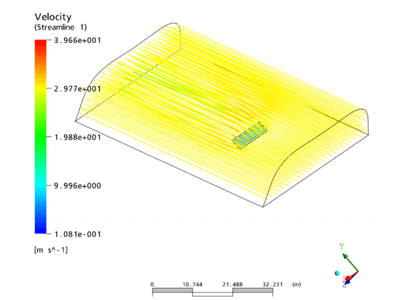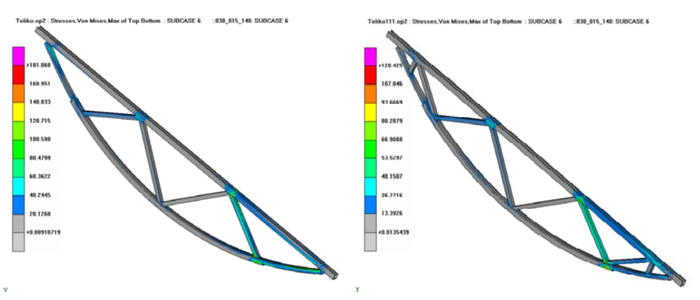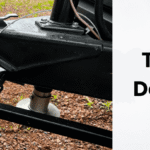The deployment of large-scale solar farms presents unique structural engineering challenges. Solar panel support structures must withstand extreme wind loads, environmental degradation, and long-term operational stresses while maintaining precise alignment and performance. At Caliber Technologies LLC, we leverage advanced Computational Fluid Dynamics (CFD) and Finite Element Analysis (FEA) to design structures that meet stringent safety, durability, and longevity requirements.

Engineering Challenges in Solar Farm Structural Design
Solar panel structures must satisfy multiple critical requirements:
- Wind Load Resistance – Solar arrays are subject to high wind velocities, often exceeding 120 km/h, generating significant dynamic pressure and uplift forces on panels and support frames.
- Structural Strength and Durability – Supports must safely carry these loads over the entire life cycle of the solar farm, typically 20+ years.
- Buckling and Failure Prevention – Tall or lightweight structures are prone to buckling and local failure, requiring rigorous analysis of critical load paths.
- Service Life Performance – Fatigue and environmental factors must be considered to ensure structural integrity under repeated load cycles and corrosion.
Advanced CFD for Accurate Wind Load Prediction
At Caliber Technologies, we utilize CFD simulations to evaluate the interaction between wind flow and solar structures:

- 3D Flow Field Analysis: High-fidelity simulations capture velocity profiles, turbulence effects, and pressure distributions around panels and support structures.
- Wind Pressure Mapping: CFD results provide spatially resolved pressure distributions for every surface, enabling accurate load calculation for structural design.
- Extreme Event Assessment: Simulations account for gusts and peak velocities exceeding 120 km/h, ensuring conservative and safe design margins.
- Array-Level Interaction: CFD can model multiple rows of solar panels to understand shielding effects, wake interactions, and overall farm-level wind loads.
By integrating CFD results directly into structural models, we provide a physics-based load input for subsequent FEA, improving confidence in structural performance predictions.
FEA for Structural Analysis and Life-Long Durability
Using CFD-derived loads, Caliber Technologies performs comprehensive FEA to ensure the structural integrity of solar farm supports:

- Strength Analysis: Evaluate stress and strain distributions throughout the frame, connections, and foundations under maximum wind loading conditions.
- Critical Point Identification: Determine locations with the highest stress concentrations or deformation, guiding reinforcement and material selection.
- Buckling Analysis: Perform eigenvalue and nonlinear buckling studies to ensure members resist global or local instability under extreme loads.
- Fatigue and Life Expectancy: Simulate repeated load cycles and environmental factors to verify that structures maintain integrity over 20+ years of operation.
- Optimization for Efficiency: Material usage and geometry are refined to balance strength, weight, and cost, achieving an economical yet robust design.
Caliber Technologies’ Approach
Our engineers combine state-of-the-art CFD, FEA, and optimization workflows to deliver robust solar farm designs:
- High-Fidelity Simulations: Coupled CFD-FEA workflow captures wind-structure interactions with unmatched precision.
- Critical Point Analysis: Advanced algorithms automatically identify vulnerable points and suggest design improvements.
- Multi-Objective Design Optimization: Structural performance, material efficiency, and installation constraints are simultaneously optimized.
- Engineering Validation: Simulation results are validated against standards, codes, and historical field data to ensure reliability.
Key Benefits Realized
- Solar structures capable of withstanding wind speeds exceeding 120 km/h.
- Optimized material usage without compromising safety or longevity.
- Identification and mitigation of structural weak points.
- Life expectancy exceeding 20 years, with minimal maintenance requirements.
- Reduced design cycle time and prototyping costs through virtual validation.
Partner with Caliber Technologies to design highly resilient solar farm structures using cutting-edge CFD and FEA methodologies. Our physics-based simulations ensure your solar assets withstand environmental extremes while maximizing operational life and cost efficiency.



